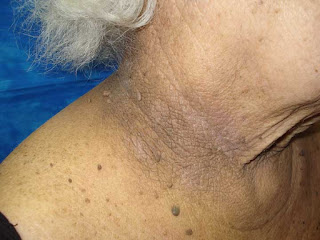History: This elderly woman presented for progressive hyperpigmentation of skin folds (neck, axillae, groin, and inframammary folds). She felt she was in good general health, but noted some recent weight loss, "bloating" and scalp pruritus. She had a sister who died of pancreatic cancer.
O/E: Velvety gray-black hyperpigmentation of affected areas. In addition some she has some verrucous tumors on arms and legs.
Clinical Photo(s):


Lab: Ultrasound of abdomen showed ascites. Abdominal CT revealed "focal masses involving the omentum and peritoneal cavity most likely representing metastatic disease. Extensive ascites, hepatic custs and a left lower lobe nodule of uncertain significance. Exploratory lap found wide-spread metastatic disease, exact cell-type could not be determined.
Histopathology: N/A
Diagnosis: Malignant Acanthosis Nigricans.
Reason Presented: For interest.
Discussion:"The exact incidence of AN is unknown. In an unselected population of 1412 children, the changes of AN were present in 7.1%. Obesity is closely associated with AN, and more than one half of the adults who weigh greater than 200% of their ideal body weight have lesions consistent with AN. The malignant form of AN is far less common, and, in one study, only 2 of 12,000 patients with cancer had signs of AN.
Malignant AN is associated with significant complications because the underlying malignancy is often an aggressive tumor. Average survival time of patients with signs of malignant AN is 2 years, although cases in which patients have survived for up to 12 years have been reported. In older patients with new onset AN, most have an associated internal malignancy." (from eMedicine chapter)
Follow-up: The patient was seen back on April 18, 2008. She has had chemotherapy and is doing OK. She was again complaining about the hyperpigmentation. She looked pretty good; but understands she has metastatic disease of unknown origin. She was looking forward to going to Florida in a few weeks to visit a daughter. She would like the dark areas treated. Tretinoin may be of some value and will be tried when she returns. In the face of a grave prognosis she is a feisty septuagenarian with a smile and a sense of humor.
References: eMedicine Chapter on A.N.
